Development of High-Yielding Upland Cotton Genotypes with Reduced Regrowth after Defoliation Using a Combination of Molecular and Conventional Approaches
Abstract
:1. Introduction
2. Materials and Methods
2.1. Plant Material
2.2. Crop Husbandry
2.3. Genetic Crossing and Advancement of Generation
2.4. Conversion of SNP Markers to User-Friendly PCR-Based Assay
3. Results and Discussion
3.1. Intraspecific Hybridization
3.2. Generation Advancement and Phenotypic Evaluation
3.2.1. F2 and F3 Generations
3.2.2. F3 and F4 Generations
3.2.3. F4 and F5 Generations
3.2.4. F5 and F6 Generations
3.3. Conversion of the Expression-Trait-Associated SNP Markers into User-Friendly PCR-Based Assays for Use in Cotton Breeding
4. Conclusions
Supplementary Materials
Author Contributions
Funding
Institutional Review Board Statement
Informed Consent Statement
Data Availability Statement
Acknowledgments
Conflicts of Interest
References
- Meredith, W.R., Jr. Cotton yield progress—Why has it reached a plateau? Better Crop. 2000, 84, 6–9. [Google Scholar]
- Smith, C.W.; Cantrell, R.G.; Moser, H.S.; Oakley, S.R. History of cultivar development in the United States. In Cotton: Origin, History, Technology, and Production; Smith, C.W., Cothren, J., Eds.; John Wiley & Sons: New York, NY, USA, 1999; pp. 99–171. [Google Scholar]
- Bowman, D.T.; May, O.L.; Calhoun, D.S. Genetic Base of Upland Cotton Cultivars Released between 1970 and 1990. Crop Sci. 1996, 36, 577–581. [Google Scholar] [CrossRef]
- Hinze, L.L.; Hulse-Kemp, A.M.; Wilson, I.W.; Zhu, Q.-H.; Llewellyn, D.J.; Taylor, J.M.; Spriggs, A.; Fang, D.D.; Ulloa, M.; Burke, J.J.; et al. Diversity Analysis of Cotton (Gossypium hirsutum L.) Germplasm Using the CottonSNP63K Array. BMC Plant Biol. 2017, 17, 37. [Google Scholar] [CrossRef] [PubMed]
- Lewis, H. A review of yield and fiber quality trends and components in America upland cotton. In Proceedings of the Beltwide Cotton Conference, Anaheim, CA, USA, 9–13 January 2001; pp. 1447–1453. [Google Scholar]
- May, O.L.; Bowman, D.T.; Calhoun, D.S. Genetic Diversity of U.S. Upland Cotton Cultivars Released between 1980 and 1990. Crop Sci. 1995, 35, 1570–1574. [Google Scholar] [CrossRef]
- Ulloa, M.; Stewart, J.; Garcia, C.E.A.; Godoy, A.S.; Gaytan, M.A.; Acosta, N.S. Cotton Genetic Resources in the Western States of Mexico: In Situ Conservation Status and Germplasm Collection for Ex Situ Preservation. Genet. Resour. Crop Evol. 2006, 53, 653–668. [Google Scholar] [CrossRef]
- Ulloa, M.; De Santiago, L.M.; Hulse-Kemp, A.M.; Stelly, D.M.; Burke, J.J. Enhancing Upland Cotton for Drought Resilience, Productivity, and Fiber Quality: Comparative Evaluation and Genetic Dissection. Mol. Genet. Genom. 2019, 295, 155–176. [Google Scholar] [CrossRef]
- Zhang, J.; Lu, Y.; Cantrell, R.G.; Hughs, E. Molecular Marker Diversity and Field Performance in Commercial Cotton Cultivars Evaluated in the Southwestern USA. Crop Sci. 2005, 45, 1483–1490. [Google Scholar] [CrossRef]
- Ulloa, M.; Wang, C.; Saha, S.; Hutmacher, R.B.; Stelly, D.M.; Jenkins, J.N.; Burke, J.; Roberts, P.A. Analysis of Root-Knot Nematode and Fusarium Wilt Disease Resistance in Cotton (Gossypium spp.) Using Chromosome Substitution Lines from Two Alien Species. Genetica 2016, 144, 167–179. [Google Scholar] [CrossRef]
- Esbroeck, G.A.; Bowman, D.; May, O.L.; Calhoun, D.S. Genetic similarity indices for ancestral cotton cultivars and their impact on genetic diversity estimates of modern cultivars. Crop Sci. 1999, 39, 323–328. [Google Scholar] [CrossRef]
- Iqbal, M.J.; Reddy, O.U.K.; El-Zik, K.M.; Pepper, A.E. A genetic bottleneck in the ’evolution under domestication’ of upland cotton Gossypium hirsutum L. examined using DNA fingerprinting. Theor. Appl. Genet. 2001, 103, 547–554. [Google Scholar] [CrossRef]
- Van-Esbroeck, G.A.; Bowman, D.T.; Calhoun, D.S.; May, O.L. Changes in the Genetic Diversity of Cotton in the USA from 1970 to 1995. Crop Sci. 1998, 38, 33–37. [Google Scholar] [CrossRef]
- Bowman, D.T.; Gutierrez, O.A. Sources of fiber strength in the US Upland cotton crop from 1980 to 2000. J. Cotton Sci. 2003, 7, 164–169. [Google Scholar]
- Wendel, J.F.; Brubaker, C.L.; Percival, A.E. Genetic Diversity in Gossypium hirsutum and the Origin of Upland Cotton. Am. J. Bot. 1992, 79, 1291–1310. [Google Scholar] [CrossRef]
- Tatineni, V.; Cantrell, R.G.; Davis, D.D. Genetic diversity in elite cotton germplasm determined by morphological characteristics and RAPDs. Crop Sci. 1996, 36, 186–192. [Google Scholar] [CrossRef]
- Abdalla, A.M.; Reddy, O.U.K.; El-Zik, K.M.; Pepper, A.E. Genetic Diversity and Relationships of Diploid and Tetraploid Cottons Revealed Using AFLP. Theor. Appl. Genet. 2001, 102, 222–229. [Google Scholar] [CrossRef]
- Gutiérrez, O.A.; Basu, S.; Saha, S.; Jenkins, J.N.; Shoemaker, D.B.; Cheatham, C.L.; McCarty, J.C. Genetic Distance among Selected Cotton Genotypes and Its Relationship with F2 Performance. Crop Sci. 2002, 42, 1841–1847. [Google Scholar] [CrossRef]
- Lu, H.; Myers, G. Genetic Relationships and Discrimination of Ten Influential Upland Cotton Varieties Using RAPD Markers. Theor. Appl. Genet. 2002, 105, 325–331. [Google Scholar] [CrossRef]
- Billings, G.T. Genetic Characterization of the Pee Dee Cotton Breeding Program. Ph.D. Thesis, Clemson University, Clemson, SC, USA, 2020. Available online: https://tigerprints.clemson.edu/all_theses/3473 (accessed on 6 August 2023).
- Lacape, J.M.; Nguyen, T.B.; Courtois, B.; Belot, J.L.; Giband, M.; Gourlot, J.P.; Gawryziak, G.; Roques, S.; Hau, B. QTL analysis of cotton fiber quality using multiple Gossypium hirsutum × Gossypium barbadense backcross generations. Crop Sci. 2005, 45, 123–140. Available online: https://agris.fao.org/agris-search/search.do?recordID=US201300979381 (accessed on 6 August 2023). [CrossRef]
- Zhang, J.; Percy, R.G.; McCarty, J.C. Introgression Genetics and Breeding between Upland and Pima Cotton: A Review. Euphytica 2014, 198, 1–12. [Google Scholar] [CrossRef]
- Yu, J.; Zhang, K.; Li, S.; Yu, S.; Zhai, H.; Wu, M.; Li, X.; Fan, S.; Song, M.; Yang, D.; et al. Mapping Quantitative Trait Loci for Lint Yield and Fiber Quality across Environments in a Gossypium hirsutum × Gossypium barbadense Backcross Inbred Line Population. Theor. Appl. Genet. 2012, 126, 275–287. [Google Scholar] [CrossRef]
- Tanksley, S.D.; Nelson, J.C. Advanced Backcross QTL Analysis: A Method for the Simultaneous Discovery and Transfer of Valuable QTLs from Unadapted Germplasm into Elite Breeding Lines. Theor. Appl. Genet. 1996, 92, 191–203. [Google Scholar] [CrossRef] [PubMed]
- Soomro, A.R.; Nachnani, G.R.; Soomro, A.W.; Kalhoro, A.D. Heterosis for yield in tetraploid cotton hybrids and their reciprocals. Pak. Cotton 1996, 40, 18–23. [Google Scholar]
- Zhang, J.F. Transferring and Utilization of Genes from Gossypium barbadense L. to G. hirsutum L. Ph.D. Thesis, Huazhong Agriculture University, Wuhan, China, 1993. [Google Scholar]
- Jinfa, Z. Registration of ‘Acala 1517-21′ Cotton Cultivar. J. Plant Regist. 2020, 14, 273–280. [Google Scholar]
- Dormatey, R.; Sun, C.; Ali, K.; Coulter, J.A.; Bi, Z.; Bai, J. Gene Pyramiding for Sustainable Crop Improvement against Biotic and Abiotic Stresses. Agronomy 2020, 10, 1255. [Google Scholar] [CrossRef]
- Fuchs, M. Pyramiding Resistance-Conferring Gene Sequences in Crops. Curr. Opin. Virol. 2017, 26, 36–42. [Google Scholar] [CrossRef] [PubMed]
- Liu, R.; Lu, J.; Zhou, M.; Zheng, S.; Liu, Z.; Zhang, C.; Du, M.; Wang, M.; Li, Y.; Wu, Y.; et al. Developing Stripe Rust Resistant Wheat (Triticum aestivum L.) Lines with Gene Pyramiding Strategy and Marker-Assisted Selection. Genet. Resour. Crop Evol. 2020, 67, 381–391. [Google Scholar] [CrossRef]
- Ashkani, S.; Rafii, M.Y.; Shabanimofrad, M.; Miah, G.; Sahebi, M.; Azizi, P.; Tanweer, F.A.; Akhtar, M.S.; Nasehi, A. Molecular Breeding Strategy and Challenges towards Improvement of Blast Disease Resistance in Rice Crop. Front. Plant Sci. 2015, 6, 886. [Google Scholar] [CrossRef]
- Das, G.; Rao, G.J.N. Molecular Marker Assisted Gene Stacking for Biotic and Abiotic Stress Resistance Genes in an Elite Rice Cultivar. Front. Plant Sci. 2015, 6, 698. [Google Scholar] [CrossRef]
- Kumar, A.; Jindal, S.K.; Dhaliwal, M.S.; Sharma, A.; Kaur, S.; Jain, S. Gene Pyramiding for Elite Tomato Genotypes against ToLCV (Begomovirus spp.), Late Blight (Phytophthora Infestans) and RKN (Meloidogyne spp.) for Northern India Farmers. Physiol. Mol. Biol. Plants 2019, 25, 1197–1209. [Google Scholar] [CrossRef]
- Djian-Caporalino, C.; Palloix, A.; Fazari, A.; Marteu, N.; Barbary, A.; Abad, P.; Sage-Palloix, A.-M.; Mateille, T.; Risso, S.; Lanza, R.; et al. Pyramiding, Alternating or Mixing: Comparative Performances of Deployment Strategies of Nematode Resistance Genes to Promote Plant Resistance Efficiency and Durability. BMC Plant Biol. 2014, 14, 53. [Google Scholar] [CrossRef]
- Naveed, S.; Jones, M.; Campbell, T.; Rustgi, S. An insight into the gene-networks playing a crucial role in the cotton plant architecture regulation. Nucleus 2023, 66. [Google Scholar] [CrossRef]
- McGarry, R.C.; Ayre, B.G. Cotton Architecture: Examining the Roles of SINGLE FLOWER TRUSS and SELF-PRUNING in Regulating Growth Habits of a Woody Perennial Crop. Curr. Opin. Plant Biol. 2021, 59, 101968. [Google Scholar] [CrossRef] [PubMed]
- Zhan, J.; Chu, Y.; Wang, Y.; Diao, Y.; Zhao, Y.; Liu, L.; Wei, X.; Meng, Y.; Li, F.; Ge, X. The MiR164-GhCUC2-GhBRC1 Module Regulates Plant Architecture through Abscisic Acid in Cotton. Plant Biotechnol. J. 2021, 19, 1839–1851. [Google Scholar] [CrossRef] [PubMed]
- Ray, L.L.; Richmond, T.R. Morphological measures of earliness of crop maturity in cotton. Crop Sci. 1966, 6, 527–531. [Google Scholar] [CrossRef]
- Munro, J.M. An analysis of earliness in cotton. Cotton Grow. Rev. 1971, 48, 28–41. [Google Scholar]
- Godoy, A.S.; Palomo, G.A. Genetic analysis of earliness in upland cotton (Gosspium hirsutum L.) I. Morphological and phonological variables. Euphytica 1999, 105, 155–160. [Google Scholar] [CrossRef]
- Guo, Y.F.; McCarty, J.C.; Jenkins, J.N.; Saha, S. QTL for node of first fruiting branch in a cross of an upland cotton, Gossypium hirsutum L. cultivar with primitive accession Texas 701. Euphytica 2008, 163, 113–122. [Google Scholar] [CrossRef]
- Li, C.Q.; Wang, C.B.; Dong, N.; Wang, X.Y.; Zhao, H.H.; Converse, R.; Xia, Z.; Wang, R.; Wang, Q.L. QTL detection for node of first fruiting branch and its height in upland cotton (Gossypium hirsutum L.). Euphytica 2012, 188, 441–451. [Google Scholar] [CrossRef]
- Dong, N.; Li, C.Q.; Wang, Q.L.; Ai, N.J.; Hu, G.H.; Zhang, J.B. Mixed inheritance of earliness and its related traits of short season cotton under different ecological environments. Cotton Sci. 2012, 22, 304–311. [Google Scholar]
- Song, M.Z.; Yu, S.X.; Fan, S.L. Genetic analysis of main agronomic traits in short season upland cotton (G. hirsutum L.). Cotton Sci. 2005, 17, 94–98. [Google Scholar]
- Naveed, S.; Gandhi, N.; Billings, G.; Jones, Z.; Campbell, B.T.; Jones, M.; Rustgi, S. Alterations in Growth Habit to Channel End-of-Season Perennial Reserves towards Increased Yield and Reduced Regrowth after Defoliation in Upland Cotton (Gossypium hirsutum L.). Int. J. Mol. Sci. 2023, 24, 14174. [Google Scholar] [CrossRef] [PubMed]
- Tyagi, P.; Gore, M.A.; Bowman, D.T.; Campbell, B.T.; Udall, J.A.; Kuraparthy, V. Genetic Diversity and Population Structure in the US Upland Cotton (Gossypium hirsutum L.). Theor. Appl. Genet. 2014, 127, 283–295. [Google Scholar] [CrossRef] [PubMed]
- Naveed, S.; Rustgi, S. Functional Characterization of Candidate Genes, Gohir.D05G103700 and Gohir.D12G153600, Identified through Expression QTL Analysis Using Virus-Induced Gene Silencing in Upland Cotton (Gossypium hirsutum L.). Agriculture 2023, 13, 1007. [Google Scholar] [CrossRef]
- Liu, J.; Huang, S.; Sun, M.; Liu, S.; Liu, Y.; Wang, W.; Zhang, X.; Wang, H.; Hua, W. An Improved Allele-Specific PCR Primer Design Method for SNP Marker Analysis and its Application. Plant Methods 2012, 8, 34. [Google Scholar] [CrossRef] [PubMed]
- Rustgi, S.; Bandopadhyay, R.; Balyan, H.S.; Gupta, P.K. EST-SNPs in bread wheat: Discovery, validation, genotyping and haplotype structure. Czech J. Genet. Plant Breed. 2009, 45, 106–116. [Google Scholar] [CrossRef]
- Darawi, M.N.; Ai-Vyrn, C.; Ramasamy, K.; Hua, P.P.J.; Pin, T.M.; Kamaruzzaman, S.B.; Majeed, A.B.A. Allele-Specific Polymerase Chain Reaction for the Detection of Alzheimer’s Disease-Related Single Nucleotide Polymorphisms. BMC Med. Genet. 2013, 14, 27. [Google Scholar] [CrossRef]
- Islam, M.S.; Thyssen, G.N.; Jenkins, J.N.; Fang, D.D. Detection, Validation, and Application of Genotyping-By-Sequencing Based Single Nucleotide Polymorphisms in Upland Cotton. Plant Genome 2015, 8. [Google Scholar] [CrossRef]
- Byers, R.L.; Harker, D.B.; Yourstone, S.M.; Maughan, P.J.; Udall, J.A. Development and Mapping of SNP Assays in Allotetraploid Cotton. Theor. Appl. Genet. 2012, 124, 1201–1214. [Google Scholar] [CrossRef]
- Jiang, Y.; Ren, Y.; Xu, X.; Wang, H.; Wei, C. Application of Allele Specific PCR in Identifying Offspring Genotypes of Bi-Allelic SbeIIb Mutant Lines in Rice. Plants 2022, 11, 524. [Google Scholar] [CrossRef]
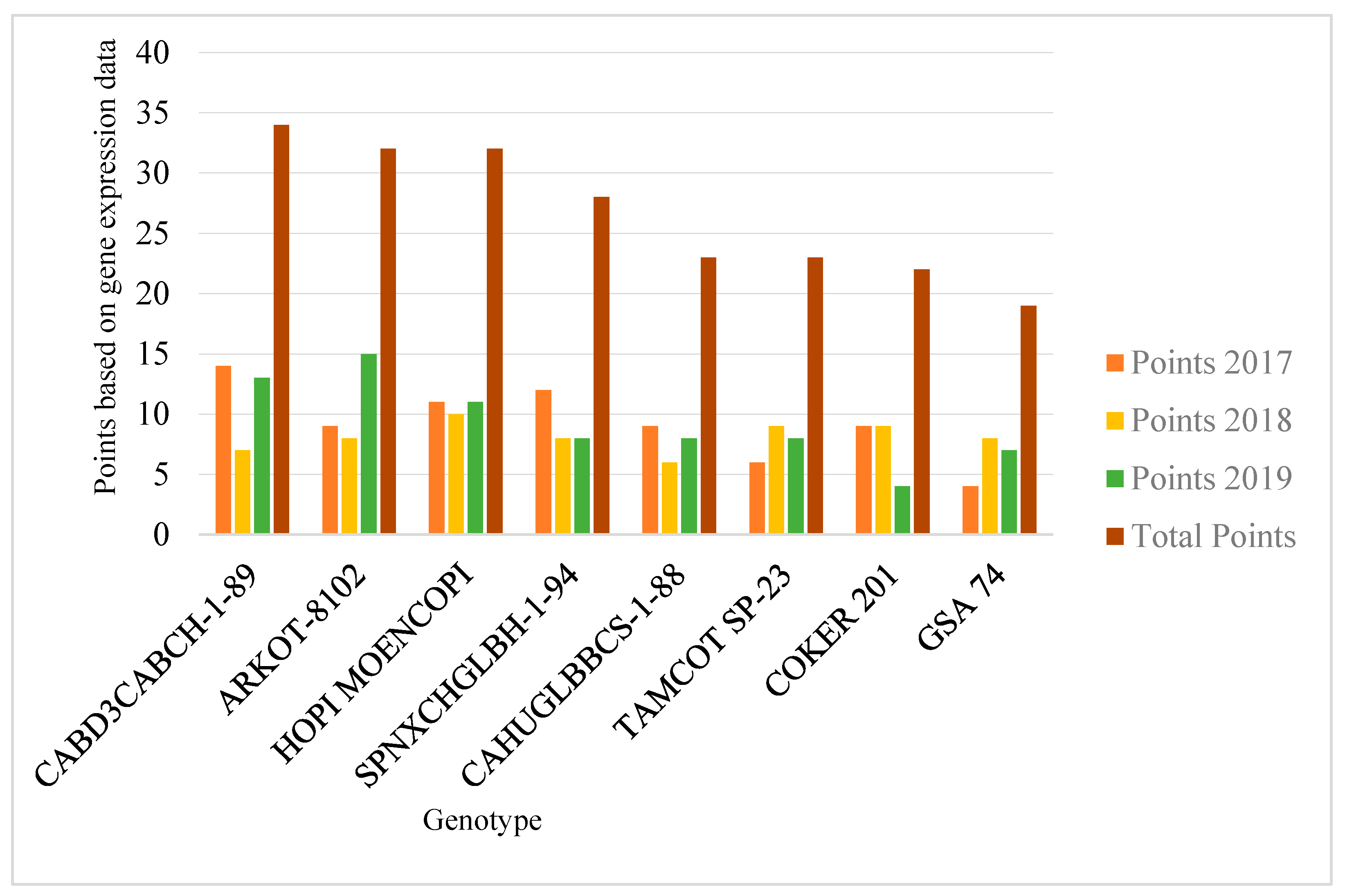
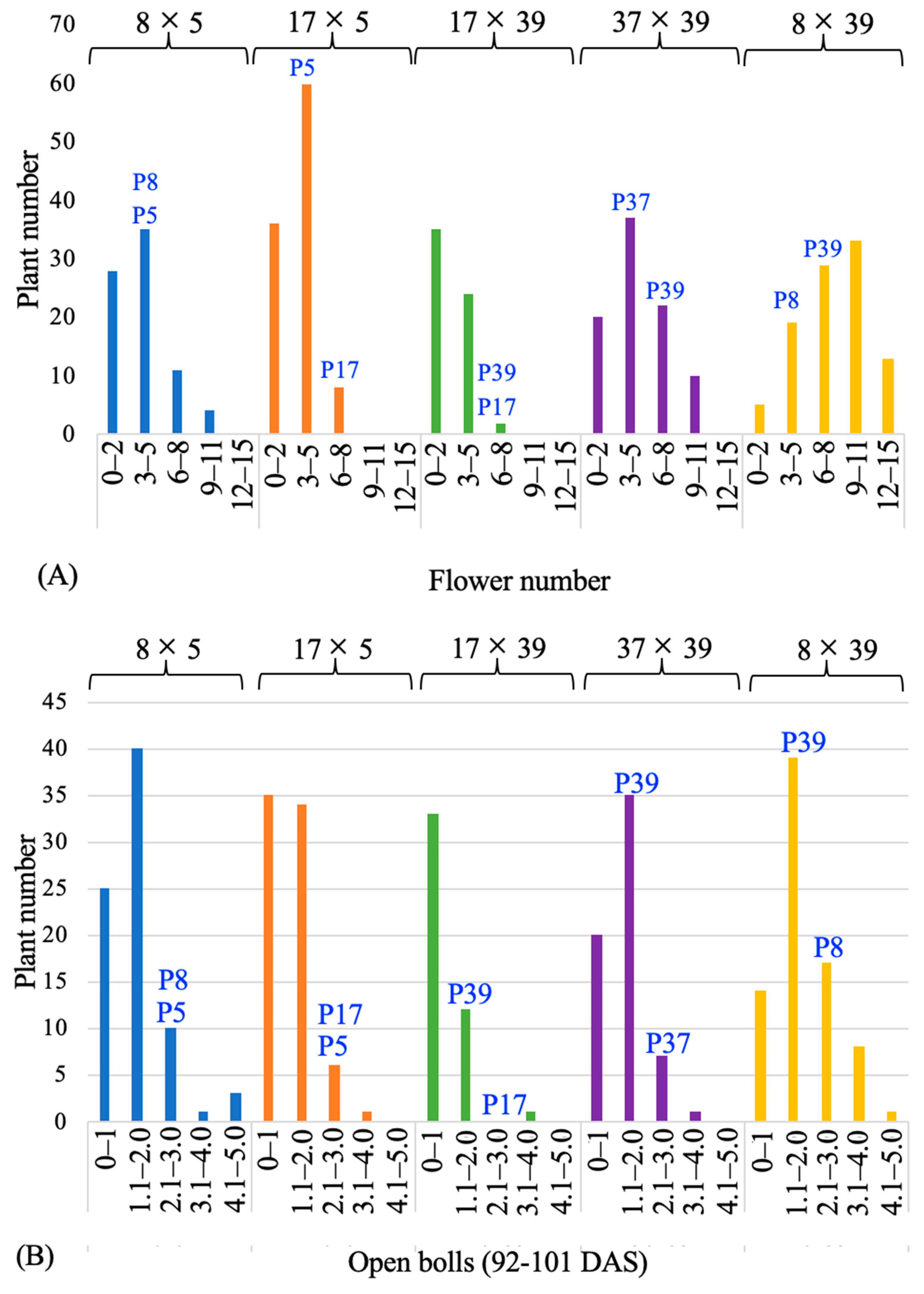
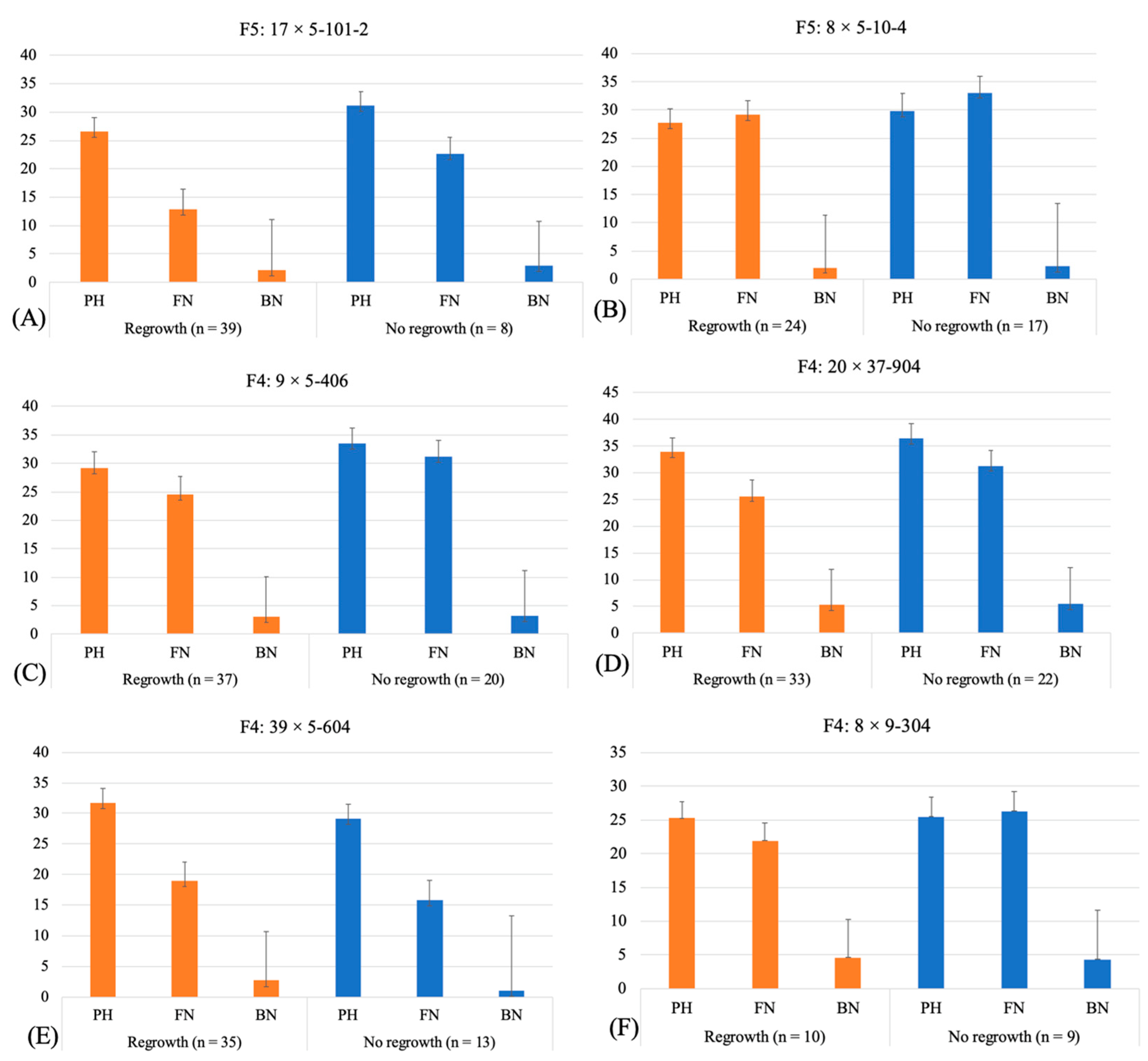
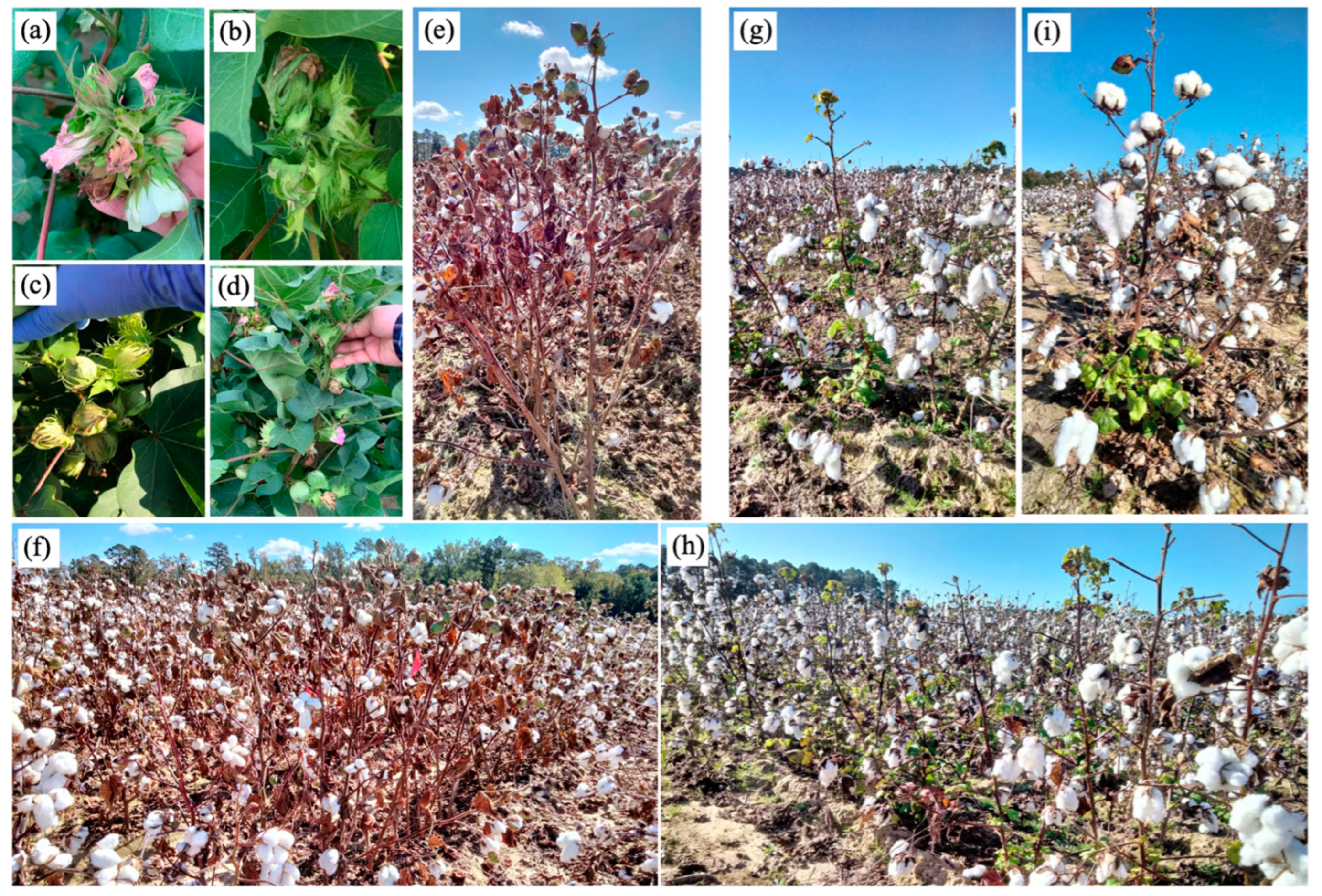
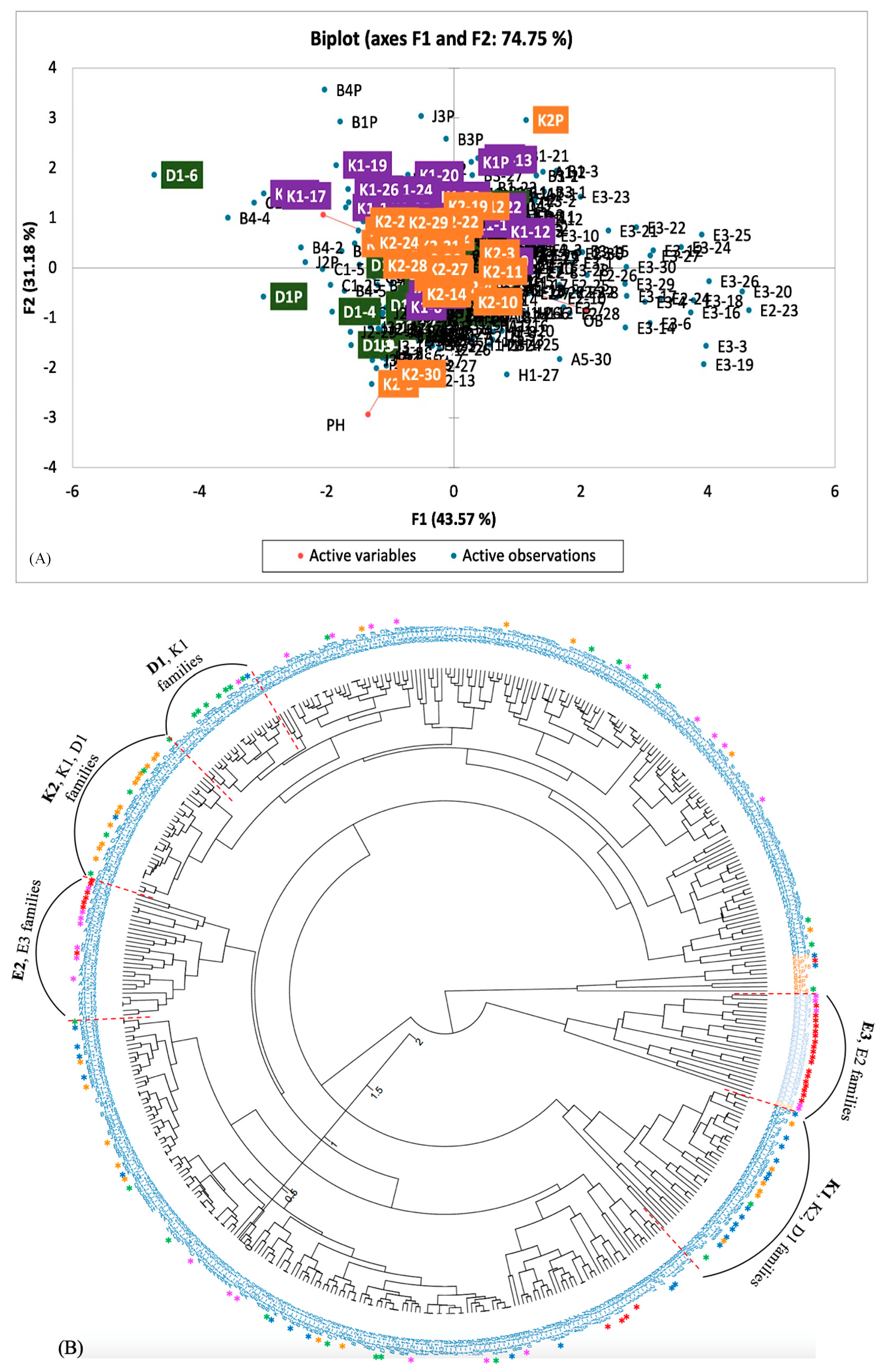
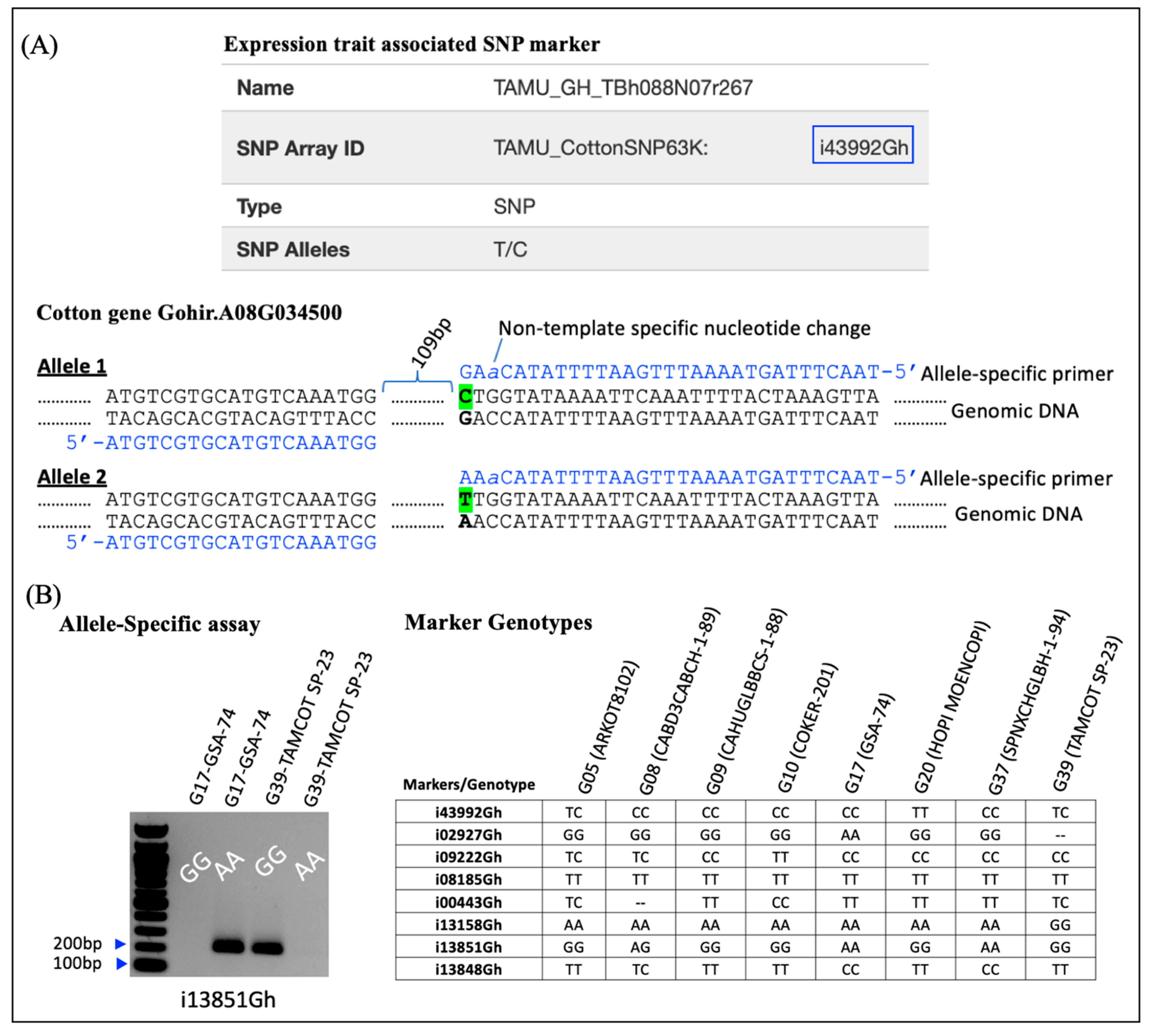
| Line | Plant Height Range (In) | Plant Height Average (In) | Boll Number (Range) | Boll Number Average | Open Bolls (Range) * | Floral Clustering (%) | Regrowth (%) |
|---|---|---|---|---|---|---|---|
| 17×5-A1 | 27.5–41.5 | 36.84 | 6–27 | 15.1 | 0–5 | 0 | 100 |
| 17×5-A2 | 29.5–46 | 40.64 | 2–24 | 13.57 | 0–4 | 0 | 100 |
| 17×5-A5 | 30.5–43 | 38.83 | 8–27 | 16.5 | 0–8 | 0 | 100 |
| 8×5-B1 | 27–38.5 | 33.53 | 3–38 | 17.12 | 0–1 | 0 | 90 |
| 8×5-B3 | 28–38 | 34.45 | 3–37 | 19.67 | 0–1 | 0 | 86.67 |
| 8×5-B4 | 34–43 | 39.48 | 9–73 | 25.97 | 0–3 | 0 | 100 |
| 9×5-C1 | 31.5–45 | 39.47 | 2–44 | 20.67 | 0–2 | 0 | 56.67 |
| 8×9-E2 | 32.5–47.5 | 38.12 | 7–47 | 18.87 | 0–14 | 0 | 86.67 |
| 8×9-E3 | 28.5–39 | 33.48 | 4–23 | 11.87 | 0–13 | 0 | 86.67 |
| 39×5-H1 | 31.5–45 | 39.93 | 4–23 | 14.4 | 0–5 | 0 | 76.67 |
| 20×5-J2 | 31.5–47.5 | 39.85 | 4–29 | 15.73 | 0–4 | 0 | 100 |
| 20×5-J3 | 33–48 | 41.88 | 5–25 | 15.2 | 0–1 | 0 | 76.67 |
| 20×37-D1 | 32–47 | 39.75 | 10–96 | 22.63 | 0 | 3.33 | 80 |
| 20×37-K1 | 28.5–38 | 35.37 | 8–68 | 31.13 | 0 | 53.33 | 16.67 |
| 20×37-K2 | 33–49.5 | 38.65 | 6–47 | 25.23 | 0–1 | 56.67 | 30 |
| DP-493 | 33.5–42.5 | 38.17 | 9–44 | 22.13 | 0 | 0 | 100 |
| FM-958 | 30–44 | 38.17 | 13–49 | 29.57 | 0–4 | 0 | 100 |
| Line | Lint Yield/Plot (lb) | Micronaire | Length | Uniformity | Strength |
|---|---|---|---|---|---|
| 17×5-A1-B1 | 11.10 | 4.84 ± 0.23 | 1.12 ± 0.05 | 81.10 ± 1.17 | 31.30 ± 1.78 |
| 17×5-A1-B2 | 13.30 | ||||
| 17×5-A1-B3 | 10.50 | ||||
| Mean | 11.63 ± 1.47 | ||||
| 17×5-A2-B1 | 16.90 | 4.84 ± 0.20 | 1.06 ± 0.09 | 81.03 ± 1.41 | 31.30 ± 1.22 |
| 17×5-A2-B2 | 16.70 | ||||
| 17×5-A2-B3 | 15.00 | ||||
| Mean | 16.20 ± 1.04 | ||||
| 17×5-A5-B1 | 13.90 | 4.57 ± 0.13 | 1.09 ± 0.04 | 79.27 ± 2.27 | 31.33 ± 1.06 |
| 17×5-A5-B2 | 11.10 | ||||
| 17×5-A5-B3 | 12.80 | ||||
| Mean | 12.60 ± 1.41 | ||||
| 8×5-B1-B1 | 16.40 | 4.86 ± 0.21 | 1.02 ± 0.01 | 82.23 ± 0.31 | 31.93 ± 1.81 |
| 8×5-B1-B2 | 9.30 | ||||
| 8×5-B1-B3 | 14.10 | ||||
| Mean | 13.27 ± 3.62 | ||||
| 8×5-B3-B1 | 15.80 | 4.76 ± 0.18 | 1.06 ± 0.06 | 82.53 ± 1.06 | 32.30 ± 1.69 |
| 8×5-B3-B2 | 12.00 | ||||
| 8×5-B3-B3 | 12.40 | ||||
| Mean | 13.40 ± 2.09 | ||||
| 8×5-B4-B1 | 15.40 | 4.68 ± 0.37 | 1.08 ± 0.05 | 82.70 ± 0.98 | 30.30 ± 0.35 |
| 8×5-B4-B2 | 14.40 | ||||
| 8×5-B4-B3 | 11.90 | ||||
| Mean | 13.90 ± 1.80 | ||||
| 9×5-C1-B1 | 17.10 | 5.15 ± 0.50 | 1.16 ± 0.06 | 81.50 ± 1.42 | 31.25 ± 1.23 |
| 9×5-C1-B1 | 17.10 | ||||
| 9×5-C1-B1 | 14.10 | ||||
| Mean | 16.10 ± 1.73 | ||||
| 20×37-D1-B1 | 17.90 | 4.11 ± 0.59 | 1.24 ± 0.08 | 83.84 ± 1.12 | 34.04 ± 1.86 |
| 20×37-D1-B2 | 19.20 | ||||
| 20×37-D1-B3 | 11.50 | ||||
| Mean | 16.20 ± 4.12 | ||||
| 8×9-E2-B1 | 11.70 | 3.27 ± 0.79 | 0.98 ± 0.02 | 79.80 ± 1.17 | 25.50 ± 2.03 |
| 8×9-E2-B2 | 11.90 | ||||
| 8×9-E2-B3 | 9.90 | ||||
| Mean | 11.17 ± 1.10 | ||||
| 8×9-E3-B1 | 13.00 | 4.04 ± 0.68 | 0.92 ± 0.07 | 79.50 ± 2.69 | 24.50 ± 2.55 |
| 8×9-E3-B2 | 9.00 | ||||
| 8×9-E3-B3 | 8.50 | ||||
| Mean | 10.17 ± 2.47 | ||||
| 39×5-H1-B1 | 14.60 | 5.26 ± 0.24 | 0.99 ± 02 | 80.93 ± 1.07 | 28.10 ± 1.60 |
| 39×5-H1-B2 | 16.00 | ||||
| 39×5-H1-B3 | 12.50 | ||||
| Mean | 14.37 ± 1.76 | ||||
| 20×5-J2-B1 | 13.50 | 4.57 ± 0.08 | 1.09 ± 0.05 | 79.73 ± 1.48 | 27.35 ± 1.21 |
| 20×5-J2-B2 | 19.50 | ||||
| 20×5-J2-B3 | 13.40 | ||||
| Mean | 15.47 ± 3.49 | ||||
| 20×5-J3-B1 | 15.20 | 4.51 ± 0.11 | 1.09 ± 0.02 | 81.60 ± 0.47 | 27.25 ± 0.96 |
| 20×5-J3-B2 | 14.70 | ||||
| 20×5-J3-B3 | 14.40 | ||||
| Mean | 14.77 ± 0.40 | ||||
| 20×37-K1-B1 | 19.60 | 5.06 ± 0.16 | 0.94 ± 0.01 | 82.30 ± 0.57 | 27.00 ± 1.01 |
| 20×37-K1-B2 | 18.00 | ||||
| 20×37-K1-B3 | 17.60 | ||||
| Mean | 18.40 ± 1.06 | ||||
| 20×37-K2-B1 | 22.10 | 3.90 ± 0.18 | 0.98 ± 0.01 | 82.17 ± 0.61 | 27.83 ± 0.78 |
| 20×37-K2-B2 | 21.20 | ||||
| 20×37-K2-B3 | 20.20 | ||||
| Mean | 21.17 ± 0.95 | ||||
| DP-493-B1 | 17.70 | 4.65 ± 0.37 | 1.12 ± 0.07 | 83.08 ± 1.54 | 33.16 ± 2.21 |
| DP-493-B2 | 17.00 | ||||
| DP-493-B3 | 18.60 | ||||
| Mean | 17.77 ± 0.80 | ||||
| FM-958-B1 | 18.20 | 5.04 ± 0.26 | 1.21 ± 0.04 | 84.96 ± 1.05 | 35.94 ± 1.17 |
| FM-958-B1 | 20.90 | ||||
| FM-958-B1 | 14.10 | ||||
| Mean | 17.73 ± 3.42 | ||||
| LSD0.05 | 1.34 | ||||
Disclaimer/Publisher’s Note: The statements, opinions and data contained in all publications are solely those of the individual author(s) and contributor(s) and not of MDPI and/or the editor(s). MDPI and/or the editor(s) disclaim responsibility for any injury to people or property resulting from any ideas, methods, instructions or products referred to in the content. |
© 2023 by the authors. Licensee MDPI, Basel, Switzerland. This article is an open access article distributed under the terms and conditions of the Creative Commons Attribution (CC BY) license (https://creativecommons.org/licenses/by/4.0/).
Share and Cite
Naveed, S.; Toyinbo, J.; Ingole, H.; Valavanur Shekar, P.; Jones, M.; Campbell, B.T.; Rustgi, S. Development of High-Yielding Upland Cotton Genotypes with Reduced Regrowth after Defoliation Using a Combination of Molecular and Conventional Approaches. Genes 2023, 14, 2081. https://doi.org/10.3390/genes14112081
Naveed S, Toyinbo J, Ingole H, Valavanur Shekar P, Jones M, Campbell BT, Rustgi S. Development of High-Yielding Upland Cotton Genotypes with Reduced Regrowth after Defoliation Using a Combination of Molecular and Conventional Approaches. Genes. 2023; 14(11):2081. https://doi.org/10.3390/genes14112081
Chicago/Turabian StyleNaveed, Salman, Johnson Toyinbo, Hrishikesh Ingole, Prasanna Valavanur Shekar, Michael Jones, B. Todd Campbell, and Sachin Rustgi. 2023. "Development of High-Yielding Upland Cotton Genotypes with Reduced Regrowth after Defoliation Using a Combination of Molecular and Conventional Approaches" Genes 14, no. 11: 2081. https://doi.org/10.3390/genes14112081
APA StyleNaveed, S., Toyinbo, J., Ingole, H., Valavanur Shekar, P., Jones, M., Campbell, B. T., & Rustgi, S. (2023). Development of High-Yielding Upland Cotton Genotypes with Reduced Regrowth after Defoliation Using a Combination of Molecular and Conventional Approaches. Genes, 14(11), 2081. https://doi.org/10.3390/genes14112081







